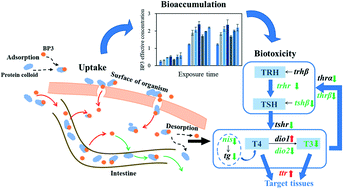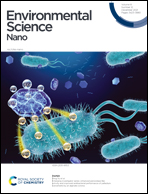Influence of organic colloids on the uptake, accumulation and effects of benzophenone-3 in aquatic animals†
Abstract
The environmental behavior of pollutants in water is associated with aquatic colloids, especially organic colloids, which may be swallowed by aquatic organisms. In this study, bovine serum albumin (BSA) and phycocyanin (PCA) as organic protein colloids were used to evaluate their impacts on the accumulation and biotoxicity of benzophenone-3 (BP3). A bioaccumulation kinetic model based on daphnids (Daphnia magna) and zebrafish (Danio rerio) was established to quantify the effects of colloids on the different absorption pathways for BP3. When the freely dissolved concentration of BP3 was fixed at 100 μg L−1, environmentally relevant concentrations of colloids always acted as a carrier in the intestine, transferring BP3 to lipids, and the positive carrier efficiency decreased with the increase of colloid concentration. Protein colloids also enhanced passive absorption, of which the efficiency increased with colloid concentration. However, the contribution of the carrier effect of colloids in the intestine was almost negligible. Two aquatic organisms obtained BP3 mainly from water, and the upper limit of bioaccumulation in the colloid matrix was dependent on the absorption of colloid–BP3 by organisms or the mass transfer on the surface of organisms. Besides, BP3 caused thyroid hormone content and gene expression disorders on the hypothalamus–pituitary–thyroid axis in zebrafish larvae. The opposite colloid concentration dependence of gene expression was observed for BSA and PCA. The colloids may affect the active BP3 concentration in organisms through their adsorption and desorption behaviour outside and inside organisms, thereby affecting the toxicity of pollutants. This study suggests reconsidering the true ecological risks of pollutants bound to organic colloids in natural environments.



 Please wait while we load your content...
Please wait while we load your content...